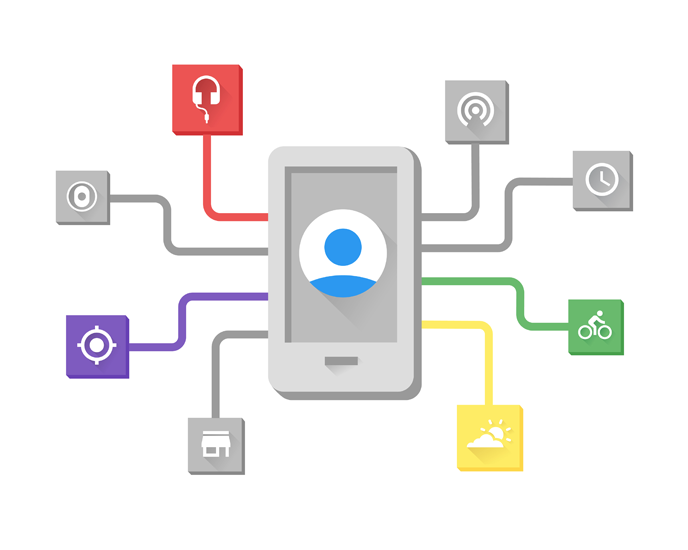Introduction
Your phone buzzes. Another notification.
However, it is different this time. Your running app is aware that you have been sitting for hours straight. It knows it’s sunny outside. It knows your usual lunch break just started.
So it gently suggests: “Perfect weather for that 20-minute run. Your favorite route is clear.”
Not creepy at all, actually, it’s pretty damn supportive if you ask me.
Look, most mobile apps these days haven’t evolved much. Everyone gets tossed into the same user experience blender.
Same exact app, no personality, no nothing. Apps just don’t care.
The app does not care. It cannot make a distinction.
And honestly? Users are tired of it.
They’re tired of apps that interrupt dinner with workout reminders. Tired of travel apps suggesting museums when they clearly prefer food tours. Tired of productivity apps that don’t understand their workflow, their rhythm, their life.
Here’s the thing though. You can fix this. You, reading this right now, can build apps that actually understand context. Apps that think. Apps that adapt.
The secret? It’s not some complex algorithm that takes years to perfect.
But here’s the kicker: with Generative AI, shaking things up is way easier than you’d think. Like, almost stupidly simple.
And yeah, I can totally guess what’s running through your head right now. “AI integration sounds expensive. Complicated. Way above my skill level.”
Wrong on all counts.
Three years ago? Sure. You’d need a data science team. Today? You need an API key and a weekend. Maybe some coffee. Definitely some patience. But that’s it.
I will teach you in this manual how to develop mobile applications that comprehend users’ locations, their activities, and their needs. No fluff. No theory. Just practical steps you can implement tomorrow.
You’ll learn to combine context signals your phone already collects with AI that can actually make sense of them. Location + time + user history + AI = an app that feels like it reads minds.
By the end, you’ll know how to build features like:
- A news app that knows when you want quick headlines versus deep reads
- A food app that suggests comfort food on stressful days and salads on motivated Mondays
- A music app that plays focus music during work hours and party mixes on Friday nights
Real features. Real value. Real connection with your users.
Ready to build context aware mobile apps with Generative AI APIs that people actually enjoy using?
Let’s go.
What Makes an App Truly Context-Aware?

I want you to think of the local coffee shop where you usually grab coffee in the morning. Walking in, the barista catches your eye. It is 7:15 in the morning of a Tuesday. You have gym clothes on.
Without a word, they are already preparing your post-workout protein smoothie. I guess it is not your usual afternoon latte.
That is context awareness. A human analogy.
Indeed, your app is capable of the same thing. Even better.
However, we need to understand first what context really is. It is not only the GPS location. That would be like saying cooking is only turning on the stove.
Context is everything surrounding a single moment. The invisible signals that make “right now” different from “five minutes ago” or “tomorrow morning.”
Context-aware systems rely on three pillars:
- Context acquisition — gathering raw signals from sensors or user behavior.
- Context interpretation — translating those signals into useful meaning.
- Context adaptation — adjusting app behavior based on that meaning.
For instance, imagine a travel assistant app. It could detect your location at an airport, notice a flight delay through connected APIs, and automatically send you lounge access info or nearby restaurant suggestions. No prompts, no effort, just seamless support.
Context-Aware Mobile Apps: Real Apps Doing It Right
Spotify’s DJ feature is genius-level context awareness.
It knows Sunday morning means chill vibes for most people. But for you? It learned you to clean the house on Sunday mornings. So it plays upbeat throwbacks that make mopping fun. It even talks to you between songs, mentioning it’s playing “your Sunday cleaning classics.”
That’s not just personalization. That’s understanding.
Google Maps does something brilliant too. It recognizes that you require different details when you are strolling through a new town as opposed to when you are driving your regular route.
Walking? It mentions landmarks. “Turn left after the Starbucks.” Driving familiar routes? It shuts up unless there’s traffic.
Even Instagram gets it. Stories from your best friends appear first on Monday morning because it knows you catch up on weekends.
It recognizes that you require different details when you are strolling through a new town as opposed to when you are driving your regular route.
Your phone is a context goldmine. You just need to start digging.
Device signals tell stories:
- Battery at 15%? Keep things light and fast
- Brightness maxed out? User’s probably outside, squinting
- Headphones connected? They can handle audio content
- Do Not Disturb on? Skip the notifications
- Storage almost full? Don’t cache massive files
Network signals matter:
- On WiFi? Stream high-quality content
- Cellular in a foreign country? Minimize data usage
- Offline? Better have something cached
- Connection dropping in and out? They’re probably on the subway
Sensor data speaks volumes:
- Accelerometer showing rhythmic movement? They’re running
- No movement for hours? Maybe suggest a stretch break
- Phone face-down? They’re trying to focus
- Constant pickup/putdown? They’re nervous or bored
Building Your Context Framework
Start simple. Pick three signals that matter most for your app.
A workout app might track:
- Time of day
- Location (gym vs home vs outdoor)
- Day of week
That’s enough to know whether to suggest a quick morning routine, a serious gym session, or a weekend outdoor adventure.
Add complexity gradually. Users opening your app at weird times? There’s a pattern there. Find it. Users always abandoning a certain feature? Context might explain why.
Here’s a simple starter framework:
text
Current Context = Location + Time + Recent Activity + User State
That’s it. Four variables that tell you almost everything.
Read Also: Best Mobile AI Frameworks in 2025: From ONNX to CoreML and TensorFlow Lite
The Difference Between Smart and Annoying
Facebook memories pop up at random times. Annoying.
Your photo app suggesting “Remember this day?” when you’re at the same location one year later? Smart.
The difference? Relevance.
Context awareness isn’t about using every signal. It’s about using the right signals at the right time. A formula:
High user intent + Relevant context + Perfect timing = Magic moment
Low user intent + Forced context + Bad timing = Uninstall
Your weather app shouldn’t buzz about tomorrow’s forecast during a movie. But catching you right as you’re setting tomorrow’s alarm? Perfect.
What Context Awareness Is NOT
It’s not stalking. You don’t need to know everything.
It’s not mind-reading. You can’t predict everything.
It’s not perfect. You’ll get it wrong sometimes.
It’s definitely not about showing off how much data you can collect. Users don’t care that you know their average walking speed. They care that you made their commute easier.
Context awareness is about service. Making life simpler. Reducing friction. Being helpful without being asked.
The Context Maturity Scale
- Level 1: Time-based
“Good morning” vs “Good evening”
- Level 2: Location-aware
“Looks like you’re at the gym”
- Level 3: Behavior-responsive
“You usually order coffee around this time”
- Level 4: Predictive
“Traffic’s building up. Leave now to make your meeting”
- Level 5: Truly intelligent
“Since you had a stressful day (calendar full of meetings), here’s that calm playlist you love, and I’ve dimmed the screen for evening reading”
Most apps never get past Level 2. With the help of Generative AI, you can jump straight to Level 5.
You just don’t need to track everything. You don’t need perfect context. You just need enough context to be helpful.
Start with one contextual feature. Make it work beautifully. Then add another.
Ready to see how AI makes this surprisingly easy?
Let’s keep going.
How Generative AI APIs Enable Context Awareness
Here’s what changed everything.
Traditional apps follow rules. If this, then that. User open the app at the gym? Show workout. User searches “pizza”? Show pizza places nearby.
Simple. Rigid. Often wrong.
Because life doesn’t follow neat if-then statements. Your user at the gym might be picking up their kid from gymnastics class. That pizza search might be for a birthday party next week, not dinner tonight.
Rules can’t handle nuance. AI can.
The Old Way vs The AI Way
Let me show you the difference.
Old approach:
JavaScript
if (location === ‘gym’ && time > 17:00) {
showMessage(“Time for your evening workout!”);
}
Works fine. Until your user changes gyms. Or switches to morning workouts. Or stops going entirely, but still drives past on their commute.
AI approach:
JavaScript
const context = gatherAllSignals();
const response = await AI.understand(context);
// AI figures out what’s actually happening
The AI doesn’t just check boxes. It thinks. Well, sort of.
It looks at patterns you couldn’t possibly code. “This user says they work out at 5 PM, but their gym visits peaked three months ago and have dropped 80%.
They’re opening fitness apps more but closing them quickly. They searched ‘home workouts’ twice. They’re probably trying to shift to exercising at home but struggling with motivation.”
You didn’t program that logic. The AI found it.
What These APIs Actually Do
You send the AI a bunch of context. User location, time, recent actions, whatever signals you’ve collected. You ask a question: “What does this user probably need right now?”
The AI has seen millions of patterns. It recognizes yours. It responds with actual understanding, not just keyword matching.
Example: Your food delivery app.
Traditional code sees: User opened app at 11:47 AM.
Response: “Looking for lunch?”
AI sees: User opened app at 11:47 AM on Tuesday. They typically order lunch at 12:30. Their calendar shows a meeting at noon. The last three orders were quick-grab items when they had schedule conflicts.
Response: “Need something quick before your noon meeting? Here are meals that usually arrive in 20 minutes.”
See the difference? It’s a guess. The other’s insight.
The Magic of Natural Language Understanding
Here’s where it gets interesting.
Users don’t communicate in clean data. They type messy things. “something healthy but not rabbit food lol” or “idk maybe pizza? but I had that yesterday” or just “🤔🍕🥗”
Good luck coding if-then statements for that.
AI gets it, though. It understands intent, mood, and uncertainty. It knows “healthy but not rabbit food” means satisfying salads or grain bowls, not plain lettuce. It catches that the emoji-only message expresses indecision between pizza and salad.
This matters more than you think.
Your meditation app user types: “can’t focus today, brain all over the place”
Traditional search finds nothing. Wrong keywords.
AI understands: They’re scattered, need grounding, and probably stressed. Serve up a breathing exercise or body scan meditation. Not the 30-minute silent sit.
Context Synthesis:
Individual data points are boring.
Temperature: 72°F. So what?
Time: 2:37 PM. Okay.
Location: Coffee shop. And?
AI connects these dots into meaning.
72°F + Sunny + Saturday afternoon + Coffee shop + Laptop open + Calendar clear = User’s treating themselves to outdoor work in nice weather. They’re relaxed. Probably won’t appreciate urgent notifications. Maybe suggest a longer-form article they saved instead of quick news bites.
You’d need hundreds of rules to capture that. AI does it instantly.
Different APIs, Different Strengths
Not all AI APIs think the same way. Choose based on what you need.
1. GPT-4 (OpenAI)
- Best at: Complex reasoning, creative responses, handling weird edge cases
- Costs: Higher, especially at scale
- Speed: Pretty fast, getting faster
- Sweet spot: Apps where response quality matters more than speed
Your language learning app using GPT-4 can explain grammar mistakes in the user’s native language, then provide culturally relevant examples. That’s sophisticated stuff.
2. GPT-3.5 (OpenAI)
- Best at: Most everyday tasks, good balance of smart and cheap
- Costs: Much more affordable
- Speed: Very fast
- Sweet spot: Most context aware mobile apps feature honestly
Is your e-commerce app making quick product recommendations based on browsing history? GPT-3.5 handles it fine. Save money for what matters.
3. Gemini (Google)
- Best at: Multimodal understanding, working with images and text together
- Costs: Competitive, free tier is generous
- Speed: Solid
- Sweet spot: Android apps, anything needing image context
Your travel app can analyze a photo the user took and suggest: “Love that architecture! There are three similar buildings within walking distance. Want directions?”
4. Claude (Anthropic)
- Best at: Following instructions precisely, safer outputs, nuanced understanding
- Costs: Similar to GPT-4
- Speed: Good
- Sweet spot: Apps where accuracy and safety matter most
Your health app giving advice needs to be careful. Claude’s more likely to say “consult your doctor” than make bold claims.
5. Local models (Llama, Mistral, etc.)
- Best at: Privacy, offline functionality, zero API costs
- Costs: Free after initial setup, but requires device resources
- Speed: Depends on device and model size
- Sweet spot: Privacy-focused apps, offline-first experiences
Your journal app can analyze entries without sending private thoughts to external servers. Users appreciate that.
Read Also: How to Build ChatGPT-Powered Apps for Business Use
How AI Learns Your Users (Without Creeping Them Out)
You’re not training models from scratch. Relax.
The AI already knows general patterns. How humans behave. What words mean. Common preferences.
Your job? Give it a specific context about this user, right now.
Think of it like briefing a really smart assistant:
“Hey, here’s what I know about this person. They usually do X. Right now, they’re doing Y. That’s unusual. What should I suggest?”
The AI fills in the gaps. It recognizes the pattern. It makes the connection.
Real Implementation: Context-Aware Notifications
Let’s get practical. Say you’re building a news app.
Without AI:
Push notifications at 8 AM and 6 PM for everyone. Hope for the best.
With AI:
JavaScript
const userContext = {
currentTime: ‘7:23 AM’,
dayOfWeek: ‘Monday’,
typicalOpenTimes: [‘7:30 AM’, ’12:15 PM’, ‘9:00 PM’],
recentTopics: [‘tech’, ‘climate’],
readingSpeed: ‘skimmer’,
commuteDuration: 25,
currentLocation: ‘near_transit_stop’
};
const prompt = `
Given this user context: ${JSON.stringify(userContext)}
We have these top stories today:
1. Major tech company announces layoffs
2. Climate summit reaches new agreement
3. Local election results
4. Sports championship game recap
Should we send a notification now? If yes, which story and what should it say?
Keep it under 60 characters.
`;
const aiDecision = await openai.complete(prompt);
The AI might respond:
“Yes. They’re about to commute and care about tech. Send: ‘Tech layoffs update – 3 min read for your commute'”
That’s not just personalization. That’s understanding.
Handling Multiple Context Layers
Users aren’t one-dimensional.
They’re a morning person AND a vegetarian AND learning Spanish AND stressed about work AND planning a trip.
Traditional code struggles with this. Too many variables. Too many combinations.
AI handles it naturally:
“User wants dinner recommendations. They’re vegetarian (dietary context). It’s late Monday (temporal context). They had a long day based on app usage patterns (behavioral context). They’re learning Spanish (interest context). They’ve been researching Barcelona (travel context).”
AI output: “How about that new tapas place? Lots of veggie options, and you can practice your Spanish with the staff. It’s cozy and quiet – perfect for unwinding.”
You didn’t program that specific combination. The AI connected the dots.
The Cost Reality
Let’s talk money. Because API calls add up.
A typical GPT-3.5 call costs about $0.002 per request. Seems tiny. But if you have 100,000 daily active users, each triggering 10 context checks… that’s $20,000 monthly.
Smart strategies:
Cache everything possible. Same context? Same answer. Don’t call the API twice.
Tier your AI usage. Use smart caching and simple rules for common cases. Save AI for complex decisions.
Batch requests. Process multiple user contexts together when real-time isn’t crucial.
Use the right model. Don’t use GPT-4 when GPT-3.5 works fine.
One developer I know cut costs 85% by caching aggressively and using smaller models for routine tasks. The user experience stayed identical.
When AI Gets It Wrong
It will. Often at first.
Your running app might suggest a jog when the user’s wearing running shoes to a casual Friday at work. Your food app might recommend brunch spots at 10 PM because the user’s sleep schedule is flipped.
The beautiful thing? AI learns from corrections.
Build in feedback loops:
“Was this helpful?” Yes/No.
“Not quite right? Tell us what you needed.”
Simple thumbs up/down.
Feed this back into your prompts:
JavaScript
const prompt = `
User context: ${context}
Previous suggestions they dismissed: ${pastMisses}
Suggestions they loved: ${pastHits}
What should we suggest now?
`;
The AI adjusts. Gets smarter. Becomes more accurate.
Privacy Without Paranoia
Users worry about AI knowing too much. Fair concern.
Be transparent. Show them what you’re tracking. Let them opt out. Process locally when possible.
Good practice:
“We use AI to suggest relevant content based on your app usage, location, and time of day. This data never leaves our servers and isn’t shared with third parties. You can turn this off anytime in settings.”
Bad practice:
Silently collecting everything and hoping nobody notices.
Trust matters. Don’t blow it for better engagement metrics.
The Implementation Checklist
Before you integrate any AI API:
✓ Define what context actually matters for your app
✓ Figure out how you’ll collect that context ethically
✓ Choose the right API for your needs and budget
✓ Build fallbacks for when AI fails or is unavailable
✓ Create feedback mechanisms to improve over time
✓ Set up monitoring to catch weird responses
✓ Plan your caching strategy to control costs
Start small. One feature. One use case. Prove it works. Then expand.
Architecture Overview: Connecting AI with Mobile Apps
Alright, let’s break down how all the moving parts fit together.
A context-aware mobile app with Generative AI isn’t some mysterious black box. It’s a clear, logical setup. Think of it as a small team where every member knows their role.
The first thing is your mobile app. That’s essentially what users see and interact with – the screens, buttons, gestures, and all the elements that give life to your product. The app, in its own way, collects context data without disturbing the user.
Things like time, motion, GPS, or even the user’s app usage patterns. Nothing fancy, just good observation.
Next comes the backend server. This is your bridge. It receives those context signals from the app and decides what needs to go to the AI. The backend filters noise, organizes data, and preps it for meaningful use. For example, instead of sending a flood of raw data, it might send a clean summary:
“User: working hours, location: office, calendar: full, energy: likely low.”
That’s where the Generative AI API steps in. The backend sends that summary as a prompt, something like:
“Given the user context, suggest a helpful productivity tip in a calm and supportive tone.”
The AI thinks, writes a short response, and sends it back. The backend then decides how to deliver, it maybe as a notification, maybe as updated text inside the app.
Here’s a simple flow:
- User context captured: location, time, activity, preferences.
- Backend cleans and summarizes data.
- Backend calls the AI API with that summarized context.
- AI generates the most fitting response.
- App updates UI or sends a notification to the user in real time.
Everything loops continuously: context updates, AI adapts, user interacts, and the system learns.
You can even add a feedback layer. Each time a user ignores or engages with a suggestion, the backend records it. Over time, the system gets smarter. The AI learns tone, timing, and relevance. That’s how an app stops feeling robotic and starts feeling aware.
If you were to sketch this on a napkin, it’d look like a triangle:
- The mobile client captures the moment.
- The backend translates the moment.
- The AI API responds with meaning.
That’s just a clean cycle of signal, sense, and response.
Building Blocks: Steps to Develop a Context-Aware AI App
Start small. Don’t try to build the “smartest” app on day one. Pick one feature that would feel more human with a touch of awareness, maybe notifications, recommendations, or chat responses.
Gather signals that matter most for that use case. Time of day, user activity, or location can already make a difference. Send those signals to your backend, frame a short prompt for your AI API, and let it respond. Test, tweak, and listen to user feedback.
Each iteration should make your app a bit more perceptive, a bit more caring.
Best Practices and Design Principles
Use data wisely. Context helps only if it respects privacy. Always be transparent about what you collect and why.
Keep AI calls efficient, cache what you can, handle slow responses gracefully, and never overwhelm users with too many “smart” suggestions.
And above all, design with empathy. Every AI response should feel like it came from someone who understands timing and tone.
Case Example: The AI Travel Assistant
Imagine a travel app that feels like a thoughtful friend. It knows you’re at the airport, senses your flight’s been delayed, and casually says,
“Looks like your flight’s running late. There’s a cozy café near Gate 14 if you need a break.”
No extra clicks. No frustration. Just helpful timing. That’s the kind of experience you’re building.
Challenges and Considerations
AI isn’t magic. It’ll get context wrong sometimes. It might overstep, misread tone, or use outdated data. That’s fine, mistakes help refine the model.
The real challenge is balance: being useful without being invasive. Give users control, and let them fine-tune how “aware” the app feels.
The Future of Context-Aware Apps
Soon, apps won’t just react, they’ll anticipate. Generative AI will combine voice, vision, and emotion to create experiences that adapt like living systems.
Picture your phone noticing your stress from your voice tone and adjusting your music or lighting automatically. That future isn’t far away; developers are already building it.
Conclusion
Context aware mobile apps with Generative AI aren’t a fantasy. They’re here, waiting for developers willing to build with a bit of curiosity and empathy.
Start with one small, meaningful use case. Let your app sense, respond, and grow. Users don’t want perfection; they want connection.
If your app can make someone feel understood, you’ve already built something special.
FAQs
- What is a context aware mobile app?
It’s an app that understands a user’s situation, like time, place, and activity, and adapts its behavior accordingly.
- How does Generative AI improve context awareness?
It helps apps interpret signals and create responses that feel human, timely, and relevant.
- Do I need deep AI knowledge to use Generative AI APIs?
Not at all. Most APIs are developer-friendly; if you can call a REST API, you can start building.
- Are context aware mobile apps safe for user privacy?
Yes, as long as you collect minimal data, stay transparent, and give users control.
- What’s the easiest way to start building one?
Pick a single feature, use a simple AI API call, test it, and learn from real user interactions.







